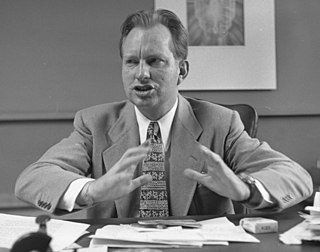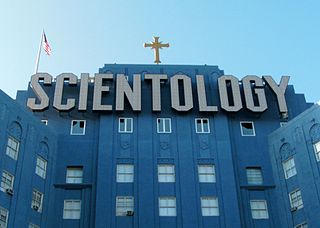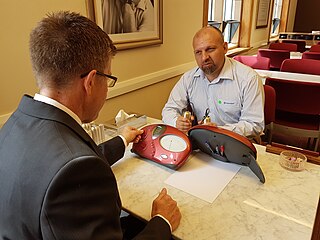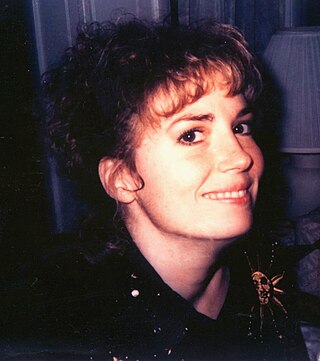
Dianetics is a set of ideas and practices invented in 1950 by science fiction writer L. Ron Hubbard regarding the human mind. Dianetics was originally conceived as a form of psychological treatment, but was rejected by the psychological and medical establishments as pseudoscientific. Dianetics was the precursor to Scientology and has since been incorporated into it.

Lafayette Ronald Hubbard was an American author and the founder of Scientology. A prolific writer of pulp science fiction and fantasy novels in his early career, in 1950 he authored Dianetics: The Modern Science of Mental Health and established organizations to promote and practice Dianetics techniques. Hubbard created Scientology in 1952 after losing the intellectual rights to his literature on Dianetics in bankruptcy. He would lead the Church of Scientology, variously described as a cult, a new religious movement, or a business, until his death in 1986.

Xenu, also called Xemu, is a figure in the Church of Scientology's secret "Advanced Technology", a sacred and esoteric teaching. According to the "Technology", Xenu was the extraterrestrial ruler of a "Galactic Confederacy" who brought billions of his people to Earth in DC-8-like spacecraft 75 million years ago, stacked them around volcanoes, and killed them with hydrogen bombs. Official Scientology scriptures hold that the thetans of these aliens adhere to humans, causing spiritual harm.
Revolt in the Stars is a science fiction film screenplay written by Scientology founder L. Ron Hubbard in 1977. It tells the space opera story of how an evil galactic dictator, named Xenu, massacres many of his subjects by transporting them to Earth and killing them with atomic bombs. L. Ron Hubbard had already presented this story to his followers, as a true account of events that happened 75 million years ago, in a secret level of Scientology scripture called Operating Thetan, Level III. The screenplay was promoted around Hollywood circles in 1979, but attempts at fundraising and obtaining financing fell through, and the film was never made. Unofficial copies circulate on the internet.

Auditing, also known as processing, is the core practice of Scientology. Scientologists believe that the role of auditing is to improve a person's abilities and to reduce or eliminate their neuroses. The Scientologist is asked questions about past events while holding two metal cylinders attached to an electrical resistance meter (galvanometer) with a dial. The term "auditing" was coined by L. Ron Hubbard in his 1950 book Dianetics: The Modern Science of Mental Health, which describes the process. Auditing uses techniques from hypnosis that are intended to create dependency and obedience in the subject.

Dianetics: The Modern Science of Mental Health, sometimes abbreviated as DMSMH, is a book by L. Ron Hubbard about Dianetics, a pseudoscientific system that he claimed to have developed from a combination of personal experience, basic principles of Eastern philosophy and the work of Sigmund Freud. The book is considered part of Scientology's canon. It is colloquially referred to by Scientologists as Book One. The book launched the movement, which later defined itself as a religion, in 1950. As of 2013, New Era Publications, the international publishing company of Hubbard's works, sells the book in English and in 50 other languages.

Scientology founder L. Ron Hubbard explicitly compared his teachings to the science-fiction subgenre space opera. In his writings, wherein thetans were reincarnated periodically over quadrillions of years, retaining memories of prior lives, to which Hubbard attributed complex narratives about life throughout the universe. The most controversial of these myths is the story of Xenu, to whom Hubbard attributed responsibility for many of the world's problems.

Since the founding of the Church of Scientology in 1954 by L. Ron Hubbard, the relationship between Scientology and psychiatry has been dominated by strong opposition by the organization against the medical specialty of psychiatry and of psychology with themes relating to this opposition occurring repeatedly throughout Scientology literature and doctrine. According to the Church of Scientology, psychiatry has a long history of improper and abusive care. The group's views have been disputed, criticized, and condemned by experts in the medical and scientific community and have been a source of public controversy.

An engram, as used in Dianetics and Scientology, is a detailed mental image or memory of a traumatic event from the past that occurred when an individual was partially or fully unconscious. It is considered to be pseudoscientific and is different from the meaning of "engram" in cognitive psychology. According to Dianetics and Scientology, from conception onwards, whenever something painful happens while the "analytic mind" is unconscious, engrams are supposedly being recorded and stored in an area of the mind Scientology calls the "reactive mind".

History of Dianetics and Scientology begins around 1950. During the late 1940s, L. Ron Hubbard began developing a mental therapy system which he called Dianetics. Hubbard had tried to interest the medical profession in his techniques, including the Gerontological Society, the Journal of the American Medical Association, and the American Journal of Psychiatry, but his work was rejected for not containing sufficient evidence of efficacy to be acceptable.

A Piece of Blue Sky: Scientology, Dianetics and L. Ron Hubbard Exposed is a 1990 book about L. Ron Hubbard and the development of Dianetics and Scientology, authored by British former Scientologist Jon Atack. It was republished in 2013 with the title Let's sell these people A Piece of Blue Sky: Hubbard, Dianetics and Scientology. The title originates from a quote of Hubbard from 1950; an associate of Hubbard's noted him saying that he wanted to sell potential members "a piece of blue sky".

This bibliography of Scientology includes Scientology and Dianetics-related books, periodicals and other issues authored by L. Ron Hubbard and those produced by the Church of Scientology and its related organizations. Books bearing L. Ron Hubbard's name are considered texts of Scientology's canon.
The amount of material on Dianetics and Scientology is extensive, to say the least. This material is composed of books by L. Ron Hubbard ; compilations of his works; taped lectures; auditor training materials ; course packages; booklets; a large number of magazines and annuals; and video recordings of the major annual events.

An incident in Scientology beliefs is something that happened to a person that continues to have a grip on their mind or spirit, and is negatively affecting them. It could be an accident or traumatic event that includes pain and subconscious commands, whether from this life or in past lives. Scientology auditing procedures are used to locate incidents in the mind, and relieve them.

The military career of L. Ron Hubbard saw the future founder of Scientology serving in the United States Armed Forces as a member of the Marine Corps Reserve and, between 1941 and 1950, the Navy Reserve. He saw active service between 1941 and 1945, during World War II, as a naval lieutenant and later as a lieutenant. After the war he was mustered out of active service and resigned his commission in 1950.

Scientology is in part derived from, and shares elements with, a number of esoteric or occult systems. The extent of the influence of specific occult belief systems on Scientology is a subject of debate amongst scholars.

This is a timeline of L. Ron Hubbard, founder of Scientology.
From his birth in 1911 until 1950, L. Ron Hubbard was a failed student, a struggling writer, a low-ranking and oft-disciplined officer in the US Navy, and an occult practitioner. His early family life included following his father, a US Navy officer, to different bases around the world, and attending university for two years. In 1933 L. Ron Hubbard married his first wife Margaret "Polly" Grubb and they had two children. The couple struggled with finances as Hubbard wrote pulp fiction. Hubbard had a short but disastrous stint in the US Navy, then immersed himself into occult practices, abandoning his first wife and marrying a second wife, Sara Northrup.
From 1950 to 1953, Hubbard led the Dianetics Movement which published, promoted and provided an alternative talk therapy called "auditing".
From 1953 to 1967, L. Ron Hubbard was the official leader of the Church of Scientology.
Scientology founder L. Ron Hubbard made a number of false claims about his life and background. His estranged son Ronald DeWolf (Nibs) reported that "Ninety-nine percent of what my father ever wrote or said about himself" was false. An acquaintance who knew Hubbard in Pasadena recalled recognizing Hubbard's epic autobiographical tales as being adapted from the writings of others. In October 1984, an American judge issued a ruling, writing of Hubbard that "The evidence portrays a man who has been virtually a pathological liar when it comes to his history, background and achievements."








